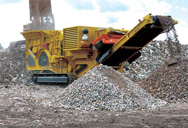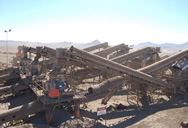


2011-12-1 Today, about 400 million tons of sulphide ore is treated annually by flotation process worldwide. General principles and factors effecting flotation process, control systems, innovations and new trends are reviewed in the paper. M/s Hindustan Zinc Ltd, a leading mining and smelting company in India treats annually 3.5 million tons sulphide ore.
Read More
New trends to flotation of fine particles are carrier flotation, column flotation and bio- flotation. In standard flotation, a low grade sulphide concentrate with 0.67 % Ni and nickel recovery Get Price
Read More
Flotation is one of the first steps in the concentration of the valuable sulphide minerals [ 6, 7, 8 ]. Xanthates are the most common collectors used to concentrate DRC ores with typical recoveries averaging around 85% for copper and 60% for cobalt, and
Read More
This technology has acclaimed importance as a versatile process for the beneficiation of vast variety of sulphide mine-rals. Due to flexibility of the process and remarkable development taken place in flotation technology and its ancillary systems, it has now become possible to recover fine grained sulphide minerals from compiled ore deposits, whose processing was earlier considered un-economical.
Read More
FROTH FLOTATION : RECENT TRENDS Flotation of FROTH FLOTATION : RECENT TRENDS @IIME, JAMSHEDPUR, 1998; pp 1841 Flotation of Sulphide Ores HZL Experience VP KOHAD Hindustan Zinc Ltd, Zawar Mines, Udaipur 313 901 ABSTRACT Flotation process, patented in the year 1906, was originally developed for mineral industry to recover values from high grade tailings of gravity
Read More
2020-7-15 The flotation of sulphide-vapour aggregates is likely to occur in crustal magma reservoirs and provides a feasible mechanism for the removal of sulphide liquid from crystal mushes, promoting its ability to participate in the generation of magmatic sulphide and porphyry copper deposits, emissions of the metals during volcanic eruptions, and even the remobilization of chalcophile metals sequestered in
Read More
1988-8-1 1988-8-1 Under favorable conditions of flotation there is competition between reactions leading to formation of hydrophobic species with reactions that lead to formation of hydrophilic species. Due to the sluggish nature of the reactions involving sulfide minerals, a knowledge of the kinetic behavior of the system is necessary.
Read More
2009-8-26 flotation of the sulphide mineral surface had been achieved at lower dosages than was required with di-C2-DTC and C2-X. The superior rate of flotation of the copper minerals with di-C2-DTP may be attributed to the added hydrophobicity provided by the additional alkyl group of di-C2-DTP compared to C2-X. However, the poor performance of di-C2-
Read More
2019-7-9 The floatability of common copper sulfide minerals is reduced in the following order: chalcopyrite > covellite > bornite > chalcopyrite. (4) The floatability of copper sulfide minerals is also affected by factors such as crystal grain size, grain size, etc. fine grain is not easy to float.
Read More
2020-4-8 2020-4-8 Gould: The key trends are toward higher mineral selectivity and greener chemistries. Currently flotation reagents are dominated by chemistries that are decades old, and in some cases more than a century old. These reagents were developed in a time when mineral head grades were much higher and environmental impacts were less of a concern.
Read More
FROTH FLOTATION : RECENT TRENDS Flotation of FROTH FLOTATION : RECENT TRENDS @IIME, JAMSHEDPUR, 1998; pp 1841 Flotation of Sulphide Ores HZL Experience VP KOHAD Hindustan Zinc Ltd, Zawar Mines, Udaipur 313 901 ABSTRACT Flotation process, patented in the year 1906, was originally developed for mineral industry to recover values from high grade tailings of gravity
Read More
2015-2-23 Model trends run from square terminations at 2,600 bar to arrow terminations at 2.7 bar. ... Flotation of sulphide drops and their ultimate release to H 2 S-rich vapours may also provide a ...
Read More
PDF FROTH FLOTATION : RECENT TRENDS Flotation of Sulphide History of Sulphide ore flotation dates back to beginning of 20th century. Sulphide ores are major sources of base metals like Copper, Lead, Zinc, Nickel, Cobalt etc. Beneficiation of these base metal sulphide minerals is predominating through froth flotation technique.
Read More
1988-8-1 The use of various electrochemical techniques to study mechanisms of sulfide mineral-flotation reagent interactions is briefly reviewed in this paper. Prior to such studies it is desirable to thermodynamically determine solution conditions favorable for formation of hydrophobic species deemed to be responsible for flotation. The thermodynamic equilibrium involving both the stable and ...
Read More
2021-4-21 [120 Pages] The global mining floatation chemicals market was estimated to be valued more than US$ 9.5 billion in terms of revenue in 2018. Mining Floatation Chemicals Market By Ore Type (Sulfide Ore, Non-Sulphide Ore), By Chemical Type
Read More
As part of a study investigating the influence of mineralogical variability in a sediment hosted copper–cobalt deposit in the Democratic Republic of Congo on flotation performance, the flotation of nine sulphide ore samples was investigated through laboratory batch kinetics tests and quantitative mineral analyses. Using a range of ore samples from the same deposit the influence of mineralogy ...
Read More
2020-4-8 Flotation has been a mainstay of mineral processing for the best part of a century, and the technology continues to develop. EMJ asked some of the world’s suppliers of equipment and reagents for their insights on current and future trends.. Flotation is one of the key technologies within the mineral processing catalogue.
Read More
2021-6-4 To participate in the 911Metallurgist Forums, be sure to JOIN LOGIN; Use Add New Topic to ask a New Question/Discussion about Flotation.; OR Select a Topic that Interests you.; Use Add Reply = to Reply/Participate in a Topic/Discussion (most frequent). Using Add Reply allows you to Attach Images or PDF files and provide a more complete input.; Use Add Comment = to comment on
Read More
The use of R and K parameters, based on laboratory data, is also important, as significant trends in R and K have been identified for controlled changes in each factor setting of the flotation system. Thus, for example, increasing the dosage of any collector consistently causes an increase in R for a given flotation feed but eventually lowers the K at higher dosage (thus, the flotation curve ...
Read More
2019-7-9 1 Types of copper sulfide ore (1) Single copper mineral Its ore characteristic is relatively simple, and the only useful component that can be recycled is copper. The gangue minerals are mainly quartz, carbonate and silicate. (2) Copper-sulfur ore Called copper-bearing pyrite. In addition to copper minerals, iron sulfide can be recovered, and the main mineral of sulfur is pyrite.
Read More
2015-2-23 Model trends run from square terminations at 2,600 bar to arrow terminations at 2.7 bar. ... Flotation of sulphide drops and their ultimate release to H 2 S-rich vapours may also provide a ...
Read More
PDF FROTH FLOTATION : RECENT TRENDS Flotation of Sulphide History of Sulphide ore flotation dates back to beginning of 20th century. Sulphide ores are major sources of base metals like Copper, Lead, Zinc, Nickel, Cobalt etc. Beneficiation of these base metal sulphide minerals is predominating through froth flotation technique.
Read More
FROTH FLOTATION : RECENT TRENDS Flotation of FROTH FLOTATION : RECENT TRENDS @IIME, JAMSHEDPUR, 1998; pp 1841 Flotation of Sulphide Ores HZL Experience VP KOHAD Hindustan Zinc Ltd, Zawar Mines, Udaipur 313 901 ABSTRACT Flotation process, patented in the year 1906, was originally developed for mineral industry to recover values from high grade tailings of gravity
Read More
2020-4-8 Flotation has been a mainstay of mineral processing for the best part of a century, and the technology continues to develop. EMJ asked some of the world’s suppliers of equipment and reagents for their insights on current and future trends.. Flotation is one of the key technologies within the mineral processing catalogue.
Read More
Chapter10 Electrochemical Flotation Separation of Sulphide Minerals ... copper sulphide minerals and the flotation oflead-zinc ... sulphide ore flotation by ... Inquire Now; FROTH FLOTATION : RECENT TRENDS Flotation of . FROTH FLOTATION : RECENT TRENDS ... 1998; pp. 18-41 Flotation of Sulphide Ores HZL Experience V.P ...
Read More
2009-8-26 Flotation of a copper sulphide ore from Okiep using thiol collectors and their mixtures The Journal of The South African Institute of Mining and Metallurgy VOLUME 105 NON-REFEREED PAPER MARCH 2005 201 Figure 1—The final cumulative copper recovery vs. collector dosage obtained with C2-X, di-C2-DTP and di-C2-DTC in the flotation of the Okiep copper ore
Read More
2020-7-10 sulphide minerals. The success of mineral flotation is contingent upon the interfacial interaction between the collector(s) and the mineral surface, was also argued in another research article [10]. In order to characterize and ascertain the mechanisms of flotation reagent interaction with rare earth oxide minerals, it was necessary to
Read More
2017-11-14 1. Mining Solutions Performance Characterization of New Frothers for Sulphide Mineral Flotation Cape Town, 14th November 2017 D. Chipfunhu G. Bournival S. Dickie S. Ata 2. Mining Solutions 2 For flotation to take place, 3 individual
Read More
2021-6-4 To participate in the 911Metallurgist Forums, be sure to JOIN LOGIN; Use Add New Topic to ask a New Question/Discussion about Flotation.; OR Select a Topic that Interests you.; Use Add Reply = to Reply/Participate in a Topic/Discussion (most frequent). Using Add Reply allows you to Attach Images or PDF files and provide a more complete input.; Use Add Comment = to comment on
Read More
2011-9-10 intergrowths (21%), Rh sulphide (11%) and Pd alloys (3%)]. Effect of pH on the Recovery and Grade of Base Metal Sulphides (PGMs) by Flotation Edson Muzenda, Member IAENG, Ayo S. Afolabi, Member, IAENG, Ambali S. Abdulkareem and Freeman Ntuli T Proceedings of the World Congress on Engineering and Computer Science 2011 Vol II
Read More
